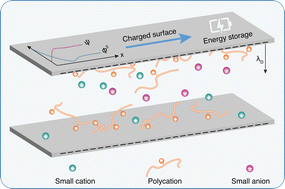Structural features and electrostatic energy storage of electric double layers in confined polyelectrolyte solutions under low-salt conditions†
Abstract
An electric double layer (EDL) in a polyelectrolyte solution plays a crucial role in diverse fields ranging from physical and life sciences to modern technologies. Due to the nonnegligible excluded volume effects, chain connectivity and complex intermolecular interactions, the EDLs in (confined) polyelectrolyte solutions display distinct features compared to those in simple electrolyte solutions. Here, we conducted a systematic study on the characteristics of EDLs in confined polyelectrolyte solutions for salt-free and low salt concentration systems using self-consistent field theory. Results suggest that the characteristic length scales measuring the EDL structures are different for positively and negatively charged surfaces. The former is the same as in the electrolyte solutions, while the latter is smaller due to the accumulation of oppositely charged polyelectrolytes near the surface. Furthermore, for low surface charge densities, a scaling law for the electrostatic energy stored in polyelectrolyte EDLs (in units of mJ m−2) was found to be U ∝ |σ|ν with ν ∼ 2–2.7, which differs from the electrolyte EDLs with ν ∼ 2; however, such a scaling law breaks down for high surface charge densities.

- This article is part of the themed collection: 2022 PCCP HOT Articles


 Please wait while we load your content...
Please wait while we load your content...